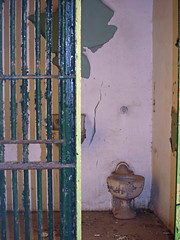
Louisiana Governor Bobby Jindal, at campaign event for presidential candidate John McCain in Kenner, Louisiana. (Photo credit: Wikipedia)
Something has to change in Louisiana, and if Bobby Jindal lives up to his latest press release it just might. It seems that some extensive changes may be coming to Louisiana’s justice system, particularly as pertains to juveniles.
First, for context, it should be established that my home state leads the planet in incarceration, with inmate populations doubling over the period between 1991 and 2012. Amnesty International reports the current number of incarcerated to be right around 40,500 which makes Louisiana’s incarceration rate the highest in the world.
An Amnesty International statement from 2008 spelled it out, and population numbers have done nothing but rise since then.
“…As of December 31, 2007, nearly 2.3 million persons were incarcerated in US prisons and jails, giving the United States the largest incarcerated population in the world. Within the US, Louisiana has the highest rate of incarceration, nearly five times that of the lowest state, Maine.”
State Governor Piyush “Bobby” Jindal has frequently come under fire for his aggressive privatization of Louisiana’s jails and prisons so it is surprising to see his latest stance on fixing a juvenile system that is rightly and frequently termed horrific. It is a stance that we here at HE espouse, and it is our hope that it gets implemented.
So, what changes are in the offing, and what response are they getting in Louisiana? The Advocate reports:
Several lawmakers, who often differ with Jindal, praised his proposals, including state Rep. Patricia Smith and state Sen. Sharon Broome, both Baton Rouge Democrats.
‘I want to thank the governor for putting treatment as a priority,’ Smith said.
Others who endorsed the changes included Debra DePrato, director at the Institute for Public Health and Justice at the LSU Health Sciences Center, and Dana Kaplan, executive director of the Juvenile Justice Project.
The plans will be included in bills submitted to the Legislature, which begins its regular session on April 8.
Jindal wants to:
- Expand what he called Louisiana’s highly successful drug courts beyond the current 48 programs statewide.
- Release certain non-sex, non-violent drug offenders into treatment rather than continued incarceration.
- Revamp a state program that he said has strayed from its mission of aiding at-risk youths.
So, in an instance that I find shocking, Louisiana politicians are getting behind the right course despite differences in party affiliation. Blue Dogs, Dixiecrats, conservatives and liberals in this most contentious of states are unifying on this subject. As a native, trust me when I say that if it can happen here it can happen anywhere in the US.
The bills to enact these changes will hit the floor in early April, so it is a little early for cheering, but just the attempt is a major step forward. Louisiana is infamous for its draconian and primitive approach to incarceration, inspired by the gaols of the French no doubt. To see a more fact-based and rehabilitation-oriented mindset become part of the process is amazing.
The part of Jindal’s plan aimed directly at juvenile justice concerns a program called FINS – Families in Need of Services. Described as a “pre-delinquency intervention” program, it was originally designed to connect with services for at-risk youth in an attempt to keep them out of the court and prison system.
According to the Juvenile Justice Implementation System, more than 11,000 youngsters between the ages of 10 and 17 were referred to them in 2010. These referrals are made by parents, teachers or law enforcement and can be for anything from truancy or running away on one end of the spectrum to criminal behavior, drug, alcohol or firearm possession on the other. The fact that these referrals are often abused makes more sense when you know that the letter of the law includes being “ungovernable” as a valid reason for them.
NOLA.com reports.
‘FINS has strayed from its mission of addressing the root causes of non-delinquent behavior, instead advancing at-risk youth through the traditional court system and further into the juvenile justice system,’ the press release said. ‘The result has been a higher juvenile incarceration rate, not less criminal behavior.’
State Rep. Patricia Haynes Smith, D-Baton Rouge, said she was ‘pleased’ with the proposal, adding, ‘We have what we call a “cradle-to-prison-pipeline.” Trying to catch juveniles before they enter into the prison system is tantamount to being able to reduce the adult prison population.’
This is big. I don’t just say that as a New Orleans native either. If Louisiana politicians can come together across party lines to enact programs like that here, then there is hope for bipartisan collaboration in other areas of the country. As our own political class is slowly realizing, it is vastly more expensive to do nothing!
Related articles
- A summary of Louisiana political news you might have missed (bobmannblog.com)
- On the declining U.S. prison population: What’s going on? (theadlerschool.wordpress.com)
- Profiling to the top lock-up state in the top incarceration nation (sentencing.typepad.com)













